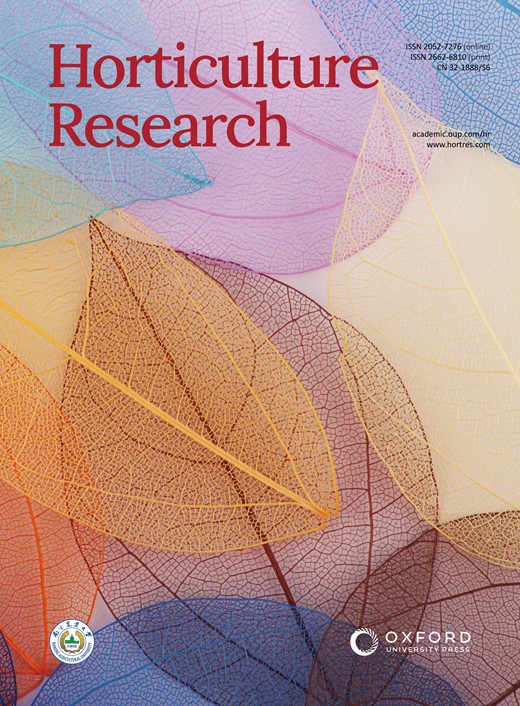Genetic architecture of cherry leaf spot (Blumeriella jaapii) resistance in sour cherry (P. Cerasus L.) uncovered by QTL analyses in a biparental population genotyped with the 6+9K SNP array
IF 8.7
1区 农林科学
Q1 Agricultural and Biological Sciences
引用次数: 0
Abstract
Sour cherry (Prunus cerasus L.) is an economically significant species in the Rosaceae family. Hitherto, there had been limited genetic and genomic resources to elucidate important horticultural traits in this species mainly because of the complex polyploid nature of its genome, a hybrid between Prunus avium and Prunus fruticosa. An important trait that has not been well studied in sour cherry is resistance to cherry leaf spot (CLS), caused by the fungus Blumeriella jaapii. This work took advantage of the RosBREED 6+9K SNP array to study the genetic basis of CLS resistance and inheritance in sour cherry. We established an F1 segregating population by crossing two cultivars, ‘Schattenmorelle’ and ‘Pc 2’ and genotyped both parents and the progeny with the cherry 6+9K SNP array and SSR markers. We evaluated both parents and progeny for resistance and susceptibility to CLS under field conditions. The applied marker systems facilitated the development of parental genetic maps, and the identification of two stable QTLs associated with CLS resistance, CLSR_1f in ‘Pc 2’ and susceptibility, CLSS_1f, in ‘Schattenmorelle’ explaining 40.9% and 21.5%, respectively of the phenotypic variation within the population. The mechanism of resistance in sour cherry appears to be independent of the CLS resistance QTL, CLSR_G4, previously identified in P. canescens, as the CLSR_G4-QTL and associated allele were not identified. Based on our findings, we propose a two-gene model for CLS resistance in sour cherry involving a susceptibility QTL, which might explain why some CLSR_G4-resistant plants in previous studies were susceptible.6+9K SNP阵列双亲本群体对酸樱桃叶斑病抗性的QTL分析揭示了酸樱桃(P. Cerasus L.)抗性遗传结构
酸樱桃(Prunus cerasus L.)是蔷薇科中具有重要经济价值的一种。迄今为止,由于其基因组具有复杂的多倍体性质,阐明该物种重要园艺性状的遗传和基因组资源有限,这主要是由于它是Prunus avium和Prunus fruticosa的杂交品种。酸樱桃的一个重要性状尚未得到很好的研究,即对樱桃叶斑病(CLS)的抗性,这是由jaapii蓝杆菌引起的。本研究利用RosBREED 6+9K SNP阵列,对酸樱桃抗CLS的遗传基础进行了研究。我们通过杂交‘Schattenmorelle’和‘pc2’建立了F1分离群体,并用樱桃6+9K SNP阵列和SSR标记对亲本和后代进行了基因分型。我们在田间条件下评估了亲本和子代对CLS的抗性和易感性。所应用的标记系统促进了亲本遗传图谱的建立,并鉴定出与CLS抗性相关的两个稳定qtl, ‘ pc2 ’中的CLSR_1f和‘ Schattenmorelle ’中的CLSS_1f,分别解释了群体内表型变异的40.9%和21.5%。酸樱桃的抗性机制似乎与先前在canescens中鉴定的CLSR_G4抗性QTL无关,因为未鉴定到CLSR_G4-QTL和相关等位基因。基于我们的研究结果,我们提出了一个涉及易感QTL的酸樱桃CLS抗性双基因模型,这可能解释了为什么以前研究中一些抗clsr_g4的植物是易感的。
本文章由计算机程序翻译,如有差异,请以英文原文为准。
求助全文
约1分钟内获得全文
求助全文
来源期刊

Horticulture Research
Biochemistry, Genetics and Molecular Biology-Biochemistry
CiteScore
11.20
自引率
6.90%
发文量
367
审稿时长
20 weeks
期刊介绍:
Horticulture Research, an open access journal affiliated with Nanjing Agricultural University, has achieved the prestigious ranking of number one in the Horticulture category of the Journal Citation Reports ™ from Clarivate, 2022. As a leading publication in the field, the journal is dedicated to disseminating original research articles, comprehensive reviews, insightful perspectives, thought-provoking comments, and valuable correspondence articles and letters to the editor. Its scope encompasses all vital aspects of horticultural plants and disciplines, such as biotechnology, breeding, cellular and molecular biology, evolution, genetics, inter-species interactions, physiology, and the origination and domestication of crops.
 求助内容:
求助内容: 应助结果提醒方式:
应助结果提醒方式:


